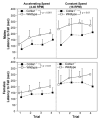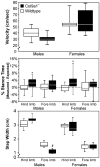Decreased physical function and increased pain sensitivity in mice deficient for type IX collagen
- PMID: 19714629
- PMCID: PMC2760314
- DOI: 10.1002/art.24783
Decreased physical function and increased pain sensitivity in mice deficient for type IX collagen
Abstract
Objective: In mice with Col9a1 gene inactivation (Col9a1(-/-)), osteoarthritis (OA) and intervertebral disc degeneration develop prematurely. The aim of this study was to investigate Col9a1(-/-) mice for functional and symptomatic changes that may be associated with these pathologies.
Methods: Col9a1(-/-) and wild-type mice were investigated for reflexes, functional impairment (beam walking, pole climbing, wire hang, grip strength), sensorimotor skills (rotarod), mechanical sensitivity (von Frey hair), and thermal sensitivity (hot plate/tail flick). Gait was also analyzed to determine velocity, stride frequency, symmetry, percentage stance time, stride length, and step width. Postmortem, sera obtained from the mice were analyzed for hyaluronan, and their knees and spines were graded histologically for degeneration.
Results: Col9a1(-/-) mice had compensatory gait changes, increased mechanical sensitivity, and impaired physical ability. Col9a1(-/-) mice ambulated with gaits characterized by increased percentage stance times and shorter stride lengths. These mice also had heightened mechanical sensitivity and were deficient in contact righting, wire hang, rotarod, and pole climbing tasks. Male Col9a1(-/-) mice had the highest mean serum hyaluronan levels and strong histologic evidence of cartilage erosion. Intervertebral disc degeneration was also detected, with Col9a1(-/-) mice having an increased incidence of disc tears.
Conclusion: These data describe a Col9a1(-/-) behavioral phenotype characterized by altered gait, increased mechanical sensitivity, and impaired function. These gait and functional differences suggest that Col9a1(-/-) mice select locomotive behaviors that limit joint loads. The nature and magnitude of behavioral changes were largest in male mice, which also had the greatest evidence of knee degeneration. These findings suggest that Col9a1(-/-) mice present behavioral changes consistent with anatomic signs of OA and intervertebral disc degeneration.
Figures




Comment in
-
The link between structural damage and pain in a genetic model of osteoarthritis and intervertebral disc degeneration: a joint misadventure.Arthritis Rheum. 2009 Sep;60(9):2550-2. doi: 10.1002/art.24771. Arthritis Rheum. 2009. PMID: 19714635 Free PMC article. No abstract available.
References
-
- The Burden of Musculoskeletal Diseases in the United States: Prevalence, Societal, and Economic Cost. Rosemont, IL: American Academy of Orthopaedic Surgeons; 2008.
-
- Battie MC, Videman T, Parent E. Lumbar disc degeneration: epidemiology and genetic influences. Spine. 2004;29(23):2679–90. - PubMed
-
- Bierma-Zeinstra SM, Koes BW. Risk factors and prognostic factors of hip and knee osteoarthritis. Nat Clin Pract Rheumatol. 2007;3(2):78–85. - PubMed
-
- Alizadeh BZ, Njajou OT, Bijkerk C, Meulenbelt I, Wildt SC, Hofman A, et al. Evidence for a role of the genomic region of the gene encoding for the alpha1 chain of type IX collagen (COL9A1) in hip osteoarthritis: A population-based study. Arthritis Rheum. 2005;52(5):1437–42. - PubMed
Publication types
MeSH terms
Substances
Grants and funding
LinkOut - more resources
Full Text Sources
Medical
Molecular Biology Databases

